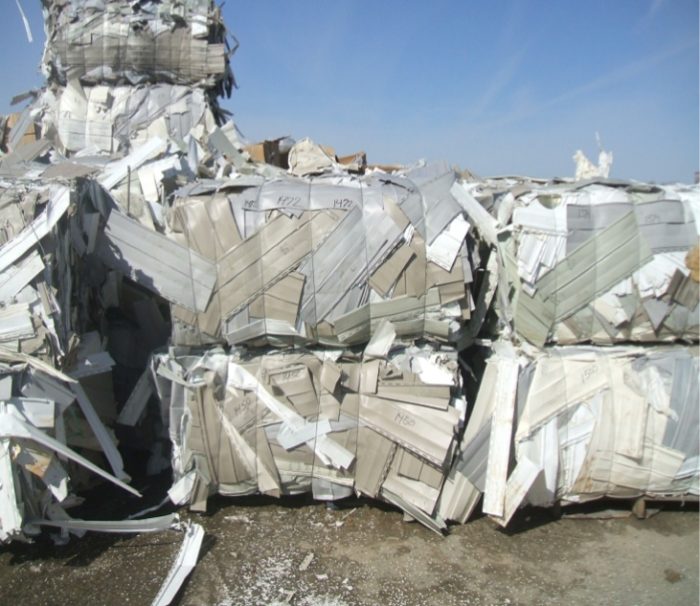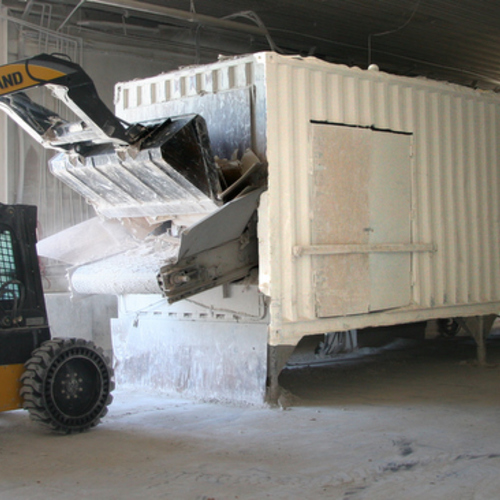
Recycled vinyl siding
PVC building products, like these bales of vinyl siding, can be recycled. Only a tiny fraction of post-consumer materials are reused. The track record for post-industrial recycling is much better.Image Credit: Vinyl Institute
Few building materials have caused more of a ruckus than polyvinyl chloride.
PVC is a light, durable and versatile plastic. Formed into a variety of building materials, it requires virtually no maintenance, and it never needs painting. These attributes make it seemingly ideal for door and window frames, pipe, floor tile, wall coverings, siding, and many other products.
Its positive attributes aside, a number of health and environmental activists wish it had never been invented. Some are pressing for a total ban on production and the substitution of other building products for those now commonly made from PVC.
Whatever side of the divide you land on, there’s no debating the fact that manufacturers turn out a great deal of PVC. More than 19 billion pounds are produced each year in North America, 76% of which goes into construction materials. Siding and soffits alone added up to nearly 2 billion sq. ft. in 2010.
Because PVC is a thermoplastic, it can be melted down and reused. The Vinyl Institute, an industry trade group, says more than 1 billion pounds of vinyl were recovered and recycled in North America in 1997.
Most of that was in the form of post-industrial scrap, material that never made it into finished goods.
Post-consumer PVC is another story. According to the Vinyl Institute, between 50 million and 100 million pounds of post-consumer PVC are recycled annually. Assuming those estimates are correct, post-consumer PVC represents 5% to 10% of the total amount the industry recycles and about one-third of 1% of the annual production of PVC building materials.
Recycling in the factory
“Today’s vinyl production is essentially closed, automated and high tech, and nearly all waste is recycled back into the system,” The Vinyl Institute says.
The Vinyl Siding Institute tells a similar story. “Vinyl siding is manufactured using an extremely efficient process with virtually no waste,” says Kelley Yoder, director of communications for the marketing and public relations firm representing the industry.
“The trimmings, shavings, color changes, and rejected parts that result during the manufacturing process are simply ground up and used again to make new siding,” Yoder says. “This contributes to the resource efficiency of manufacturing this product.”
“The chemistry of the material lends itself very favorably to [post-industrial] recycling,” Kevin Mulvaney, vice president of marketing and communications for The Vinyl Institute, said in an interview. “And yes, the post-industrial piece of our recycling equation is in fact very strong.”
The Vinyl Institute estimates that as little as 1% of post-industrial scrap ends up in landfills.
Recycling in the field
More challenging than gathering post-industrial scrap is collecting and processing post-consumer vinyl — the pipe, siding, floor tile, and other materials that have seen the end of their service life, as well as the cut-offs and other scraps generated during construction.
Overall, the VI says between 2 billion and 2.5 billion pounds of end-of-life vinyl products are landfilled annually (the EPA’s estimate is slightly higher).
While PVC is theoretically pretty simple to recycle, there can be several practical difficulties.
One is the additives that are blended with PVC when building products are originally made. Those may include colorants, plasticizers, and heat and UV stabilizers, which are used to make the resin suitable for specific uses. Manufacturers use exact formulations to give PVC certain properties; a good mix for vinyl siding isn’t necessarily the best for vinyl flooring tiles or vinyl window frames. The blend is easy to control when the manufacturer uses virgin materials, but more complicated when the recycled waste stream includes a number of different kinds of PVC products, each made a little differently.
Manufacturers have to take the particular chemistry of recycled PVC and weigh it against the requirements for new products. “I wouldn’t say it’s problematic,” Mulvaney says. “I’d say it’s a consideration that has to be taken into account when you’re formulating the new product.”
Although it seems counterintuitive in light of how much PVC is produced, inadequate supply is another potential problem for manufacturers who want to use recycled resin.
In order to make post-consumer recycling successful, manufacturers need a steady, reliable source of material, and both Mulvaney and Yoder say the material’s durability is one reason the rate of post-consumer recycling has been low.
“First of all,” says Mulvaney, “the durable nature of PVC products affects the supply of post-consumer PVC material. PVC pipe goes into the ground conceivably for 100 years. When you side your house, most manufacturers warranty their product for 25 years and up, so the material stays in use for a much longer period than other materials. The post-consumer side of things is, in fact, generally pretty low because of that.”
And this from Yoder: “Recycling vinyl siding from homes and commercial establishments has been difficult because of the challenge of obtaining large, consistent supplies of this material … As with any recycled product, recycling only succeeds when there is enough scrap to economically recycle.”
Finally, there is the problem of contamination. PVC building products collected in demolition and remodels may contain nails, flashing, wood, and other debris that must be removed before the resin can be reused.
The Healthy Building Network, an organization that promotes the use of non-toxic, non-polluting materials, says on its website, “Large-scale post-consumer recycling [is] nearly impossible for most products and interfere[s] with the recycling of other plastics.”
“The Association of Post Consumer Plastic Recyclers declared efforts to recycle PVC a failure and labeled it a contaminant in 1998,” the website states.
When I called the Association, however, a spokesman said he had never heard of the report, and calls to the Healthy Building Network went unanswered. So the source and context of the claim is unknown.
Recycling can work
In a blog earlier this year, GBA technical director Peter Yost wrote about his experience with a vinyl siding recycling project in Michigan in the late 1990s. Installers returned cut-offs to the retailer where they purchased the material. When a 20-ton load had been collected and baled, a plastics broker sold it.
Yost said in his blog that Eikenhout Inc., the distributor taking part in the 1998 program, was still accepting siding cut-offs. In fact, Eikenhout is one of several firms mentioned by the Vinyl Siding Institute as PVC recyclers that accept both cut-offs and old vinyl siding from remodeling projects. Manufacturers have partnered with a number of recyclers to use post-consumer PVC products to make new building materials, the VSI says.
Among them is CertainTeed, which announced in January 2010 that its CedarBoards vinyl clapboard siding contained 60% recycled material. That included scraps from job sites, vinyl siding distributors, and other post-consumer sources. Charlotte Pipe and Foundry Co. now makes a co-extruded pipe called RePVC whose center layer is 100% recycled material. Virgin PVC is used for inner and outer layers.
The industry does not have precise estimates of how widespread the practice is, but it can point to a number of specific initiatives. Some of them date back to the early 1990s. They include:
- The conversion of 19 million pounds a year of post-consumer vinyl composition tile into new tile at a Mannington facility in New Jersey. The new, premium-grade tile contains 25% recycled content.
- A recycling effort in Massachusetts that diverted 4 million pounds of vinyl roofing membrane from state landfills.
- A program by LSI Wallcovering in Louisville, Kentucky, that became the first in North America to collect old wall coverings and recycle them into new product, what the Vinyl Institute calls closing “the recycling loop.”
- The development of Eco-Grip non-slip vinyl flooring by Allied Companies of Jonesville, S.C., that incorporates recycled, flexible PVC.
At least part of the incentive comes from green rating systems, such as LEED for Homes or the National Green Building Standard, which award points for materials containing recycled content.
“There’s a great deal of incentive if you look at the green building movement for recycled content being part of a multi-attribute approach to how you look at material selection,” Mulvaney says. “The marketplace has of course created demand, and we see that on the rise.”
Looking to Europe
If post-consumer recycling is still in its infancy in the U.S., Europe seems to have jumped on the problem, first with the industry’s Vinyl 2010 project and now with its successor, VinylPlus.
Vinyl 2010 was a 10-year voluntary program that sought to create an infrastructure capable of collecting and recycling more than 250,000 tons of post-consumer PVC a year. Other goals included the “responsible use” of PVC additives, a phase-out of lead-based stabilizers, and development of recycling technologies, such as Vinyloop, that produced high-quality recycled resin.
VinylPlus has a number of objectives. Among them: to recycle 800,000 tons of PVC per year by 2020; develop new technologies to handle PVC products that are inherently difficult to recycle; replace lead-based additives in all 27 EU countries by the end of 2015; and to reduce energy consumption by resin producers by 20%.
Finding a recycler near you
The U.S. vinyl and recycling industries don’t have anything this ambitious.
Neither the Construction Materials Recycling Association nor the Association of Postconsumer Plastic Recyclers has any programs specifically aimed at reusing PVC.
However, The Vinyl Institute does provide two sources of information. Its Vinyl Recycling Directory is a searchable data base of companies that accept vinyl for processing. Plug in your state and the type of plastic you want to unload, and the database produces the names of companies that meet the criteria.
In addition, there’s a directory of manufacturers that use recycled vinyl to make new products.
In the meantime, waste continues to accumulate. If the industry is producing 14 billion pounds of PVC construction materials per year, and recycling and reusing 1 billion pounds, more than 13 billion pounds of PVC construction materials enter the marketplace annually. At some point, these goods will wear out or wind up as demolition debris.
Greenpeace, a strident PVC critic, estimates the accumulation of “long-life” PVC goods at roughly 75 million tons in the U.S. and more than 250 million tons worldwide. All of these goods, the environmental group says, will enter society as waste over the next three to four decades.
Weekly Newsletter
Get building science and energy efficiency advice, plus special offers, in your inbox.















One Comment
seeing the forest (industry) through the trees (product)
I am happy to read a blog on this website that tries to understand the implications of a building product in the scale of its industrial production.
The challenge is getting authoritative and transparent information about what is really happening. While some of the data provided by the products institutional representatives is useful we would be niave to think that it would sufficiently describe the impacts on the environment.
I believe that large amounts of PVC and similar plastic compounds produced and landfilled will continue to release harmful chemical compounds into the environment that damage biochemical processes and be destructive to the well being of animal life. The negative impacts of industrial processes only improve when there is focused regulation and the blog above noted some of the differences between Europe and the US.
In the case of PVC does recycling the product have less of an impact than producing the product from virgin materials? Probably but I assume most people like myself neither know the ramifications of recycling the product or even what the virgin materials are.
Climate change has a metric in CO2 content in the atmosphere that more and more people are rallying around. I heard an interesting concept today in 'slavery footprint' around revelations that the industrial production of tomatoes in Florida is in part based on slave labor. Chemicals released into the environment is maybe more difficult to package into a measure impact that would help more people be concerned.
Log in or create an account to post a comment.
Sign up Log in